More lateral pulling
June 28, 2012

As you may recall from earlier this week, we are currently in the process of pulling laterals off of our vines. Laterals are secondary shoots that sprout from this years new shoots, instead of from the woody sections of the vine. Left unchecked, laterals can make the canopy enormous, which creates grapes that taste vegetal and lack depth of flavor.
Yesterday we finished Montana Vista at the top of the property. That site is vigorous, so we usually start there. After finishing Montana Vista, we moved into the Foxtrot block further down the hill.

So far we’ve gotten about half of this block of Cabernet Sauvignon finished, we will likely complete the rest today.
This process takes a fair amount of expertise and a lot of time to do correctly. The workers have to carefully select out only the lateral shoots for removal, taking out a fruit-bearing shoot by accident would mean losing crop and upsetting the overall balance of the canopy. Every cut has to be deliberate and well thought out, the crew has to know what they are doing or the resulting quality of the grapes and wine could be adversely effected.
This is just another example of how much effort it takes to produce excellent wines!
To visit the Amapola Creek Winery main site, please click here.
Pulling laterals
June 25, 2012

Now that we’re done cane positioning, we are transitioning over to pulling ‘laterals’. A lateral is a shoot that is growing out of a new bud on one of this years new shoots.

This is a lateral shoot, note how it has sprouted from a green shoot, as opposed to a dormant bud on one of the woody parts of the plant.
Grapevines like to grow. A lot. From the vines’ point of view, the best thing it can do is get as large as possible. Since we removed a number of shoots from the vines earlier this year, they are now trying to compensate by pushing laterals.
Montana Vista, the block of Cabernet Sauvignon near the top of the property, has several sections which are quite vigorous (the vines grow quickly), so the effect of lateral growth is most obvious there.
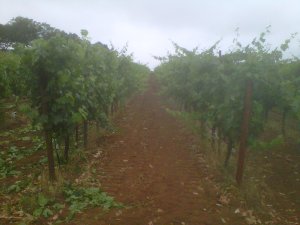
This is what the canopy looks like once the laterals start to grow out. Note how large and bushy the vines appear; in this state the canopy would provide too much shade for the fruit and the airflow around the fruit would be restricted, both of which favor the growth of mildew and would later interfere with ripening.
Once the laterals are removed, the vines start to look much as they did just after cane positioning, with the shoots trained more or less vertically, instead of growing out horizontally into the row.

This kind of hand-work in the vineyards is pretty much non-stop this time of year, the vines will continue to grow and we will continue to trim them back into the shape that will produce the highest quality wine. You can get an idea of how much the vines are growing by looking at how much vegetation has been discarded in the row. All of that is lateral shoots that have grown in the last couple of weeks.
To visit the Amapola Creek Winery main site, please click here.
Suckering the Grafted Vines
June 22, 2012

As you may recall, this year we have grafted some of our Cabernet Sauvignon vines over to Grenache and Mourvedre in order to boost our production of Cuvee Alis. The grafting itself, or T-budding, happened back around the beginning of May. Since then, we have been letting nature take its’ course. The grafted Grenache and Mourvedre buds have been growing, but so have latent Cabernet Sauvignon buds from all over the trunks of the vines.
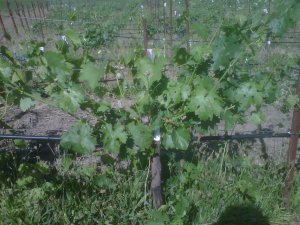
Most of the green tissue you can see here is actually Cabernet Sauvignon which we want to remove. We let the Cab shoots continue to grow in the early part of the season so that the Grenache shoots will not get too long and unruly, which would make them hard to work with next year.
This week we have been suckering the grafted vines, which is to say that we have removed all of the green shoots except for those emerging from the grafted buds.

It’s surprising how much smaller the vine looks after the unwanted shoots are stripped away. Now that the vines have been suckered the shoots emerging from the grafted buds will have much less competition, and so they will start to grow much more quickly.
To visit the Amapola Creek Winery main site, please click here.
Great press for the 2009 Monte Rosso Zinfandel!
June 21, 2012
Here’s another of the great reviews our wines have gotten in the last few days! This one is from Hayley Hamilton of Side Dish magazine;
“Iconic California winemaker Richard Arrowood just released his 2009 Amapola Creek Monte Rosso Vineyard Zinfandel made from 100+year old Zinfandel vines grown in the mineral rich, mountainous vineyard. This is a soft and supple wine filled with freshly cracked black pepper, ripe red cherries, dried berries and toffee with lingering aromas of violets and wild flowers on the finish.”
This has been a great week for us, it’s fantastic to hear such wonderful things about our wines!
To visit the Amapola Creek Winery main site, please click here.
Time to Irrigate
June 20, 2012

We’ve been having some very warm weather for the last week or so here in Sonoma Valley, and so it is time to begin irrigating our vineyards. If a vineyard is set on a valley floor, where the soil is deep and the water table is relatively high, it is possible to grow grapes that do not require irrigation. All of our vineyards are set high up off of the valley floor, where soil moisture eventually disappears to the point that grapevines cannot survive without some irrigation. This is actually advantageous in terms of wine quality; when a vine has constant access to water, it will take that water and send it straight into the grapes, sort of ballooning them up, diluting their flavor and tannins. Being able to control the water status of our vines allows us to keep the berries small and very flavorful, with plenty of ripe tannin.

This is the device that we use to apply water to the vines. It is called a ‘drip irrigator’, and it is designed to slowly release exactly one gallon of water onto the soil for every hour that we let the water run. Every vine has one drip irrigator stationed near it, so we are able to easily determine how much water each vine is getting by scheduling irrigation to run for a determinate period of time (e.g. if we run the irrigation for eight hours, then every vine will have received eight gallons of water).
While it is currently warm out, the fully grown vines are not really in any danger from water stress yet. However, some of the younger vines, (vines that are replacing those that have died in previous years) are actually in need of water this time of year, so it’s important to start getting water out in the field to keep them alive.
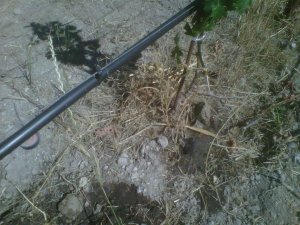
You can see in this picture that water is being sent directly to the base of the young vine to help it establish it’s roots. If you look in the bottom left hand corner of the picture, you will see that there is water being dripped onto apparently open ground. When applying water for adult vines, we like to let the water drip some distance from the base of the trunk, this encourages the vine to develop a more extensive network of roots, which will in turn help it take advantage of the dilute, naturally occurring nutrients available in organically farmed soil.
To visit the Amapola Creek Winery main site, please click here.
More nice reviews!
June 18, 2012
We’ve had a flurry of exciting reviews of our wines recently, here’s what David White of the Terroirist wine blog had to say about our 2009 Cuvee Alis;
SRP: $48. On the nose, a dark and brooding Rhone blend. Dark soil and earth, followed by layer after layer of blackberries and black cherries, followed by bittersweet chocolate, chili paste, and some graphite. On the palate, lots of black pepper comes out. The wine has gentle tannins and juicy acidity, but some astringency shows itself at the finish. A big wine that’ll likely take a few years to settle down – and will likely mature into something delicious. (91 pts.)
You can actually find a second excellent review of this wine by clicking through the Terroirist link above, and then clicking the link ‘2009 Amapola Creek Cuvee Alis Estate’, which is just above the text of David’s review.
This wine has been beautifully received by critics, we are very proud of it and hope you all get a chance to enjoy it!
To visit the Amapola Creek Winery main site, please click here.
Set!
June 14, 2012

Flowering is completely over in our vineyards, which means that the former flowers have moved on to the stage known as ‘set’. Set is when tiny little grapes start to form on the clusters. This is the stage where we start to get an idea how much crop we are likely to see this year.

Not every flower turns into a grape. There are a number of factors that determine how well grapes will set after flowering, such as vine nutrition, weather, and soil water status. This year we did see some late rains and strong winds that could potentially have damaged the flowers, from the looks of things however we will still have plenty of grapes to crush!
When a flower fails to set into a berry, we say that it has ‘shattered’. Shatter is actually a good thing, provided that it happens on a relatively small scale, every time a flower shatters it leaves a little grape-sized hole in the final cluster which helps light and air penetrate to the center. This aids ripening and discourages the spread of rot.
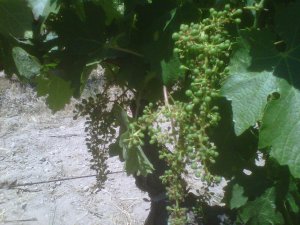
We’re very close to being done with cane positioning, which means that all of our canopies are quickly approaching their final shape. Now that we are starting to see a pretty good set it’s becoming apparent that we are in for a very good year!
To visit the Amapola Creek Winery main site, please click here.
More cane positioning
June 8, 2012
We’ve spent all week getting canes positioned in the China Bowl block at the foot of the property. This is our largest block, and so it is taking us some time to get it finished.

The rows in this section of the block are quite long. This is painstaking work, so it takes the crew days to move from one end of the vineyard to the other while cane positioning.
There is still a fair amount to go, but we’re hoping to have it sewn up by the middle of next week.
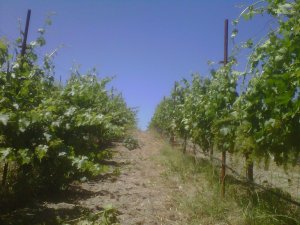
The weather lately has been warm, but not so warm that the vines are particularly stressed. As a result, the vines are growing very quickly. In this picture you can see how big the shoots are getting on the left, and on the right you can see how much cane positioning does to rein that growth in and properly shape it.
In other news, we are almost all the way through bloom, which means that we are starting to get an idea of what our crop for the year may look like in the near future. Be sure to check back to find out what we’re seeing!
To visit the Amapola Creek Winery main site, please click here.
Praise for the 2009 Cuvee Alis
June 5, 2012
Another great review from Josh Raynolds of the International Wine Cellar, this time for our 2009 Cuvee Alis, a Rhone red blend.
2009 Amapola Creek Cuvee Alis, 90 points
“Opaque ruby. Smoky, highly perfumed bouquet evokes black raspberry, cherry-cola, dried flowers and anise, with a peppery topnote. Weighty dark berry flavors become livelier with air and pick up an element of spiciness. Finishes tangy and long, with lingering smoke and vanilla qualities.”
Thanks again for the kind words, Josh!
To visit the Amapola Creek Winery main site, please click here.



